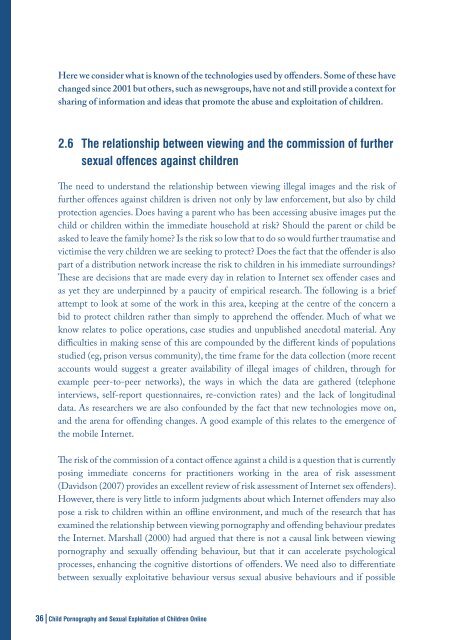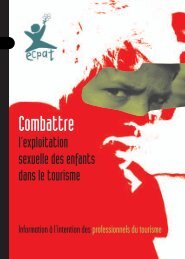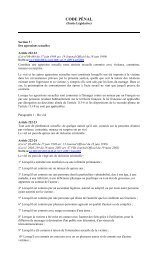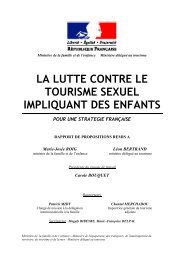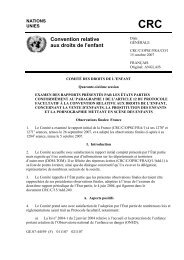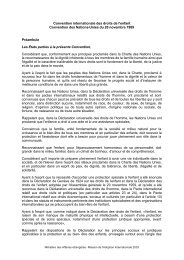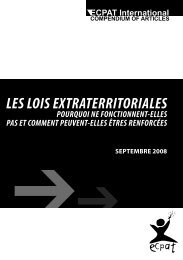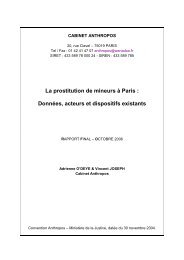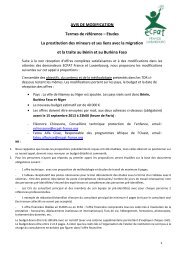child pornography and sexual exploitation of children online
child pornography and sexual exploitation of children online
child pornography and sexual exploitation of children online
Create successful ePaper yourself
Turn your PDF publications into a flip-book with our unique Google optimized e-Paper software.
Here we consider what is known <strong>of</strong> the technologies used by <strong>of</strong>fenders. Some <strong>of</strong> these have<br />
changed since 2001 but others, such as newsgroups, have not <strong>and</strong> still provide a context for<br />
sharing <strong>of</strong> information <strong>and</strong> ideas that promote the abuse <strong>and</strong> <strong>exploitation</strong> <strong>of</strong> <strong>child</strong>ren.<br />
2.6 The relationship between viewing <strong>and</strong> the commission <strong>of</strong> further<br />
<strong>sexual</strong> <strong>of</strong>fences against <strong>child</strong>ren<br />
The need to underst<strong>and</strong> the relationship between viewing illegal images <strong>and</strong> the risk <strong>of</strong><br />
further <strong>of</strong>fences against <strong>child</strong>ren is driven not only by law enforcement, but also by <strong>child</strong><br />
protection agencies. Does having a parent who has been accessing abusive images put the<br />
<strong>child</strong> or <strong>child</strong>ren within the immediate household at risk? Should the parent or <strong>child</strong> be<br />
asked to leave the family home? Is the risk so low that to do so would further traumatise <strong>and</strong><br />
victimise the very <strong>child</strong>ren we are seeking to protect? Does the fact that the <strong>of</strong>fender is also<br />
part <strong>of</strong> a distribution network increase the risk to <strong>child</strong>ren in his immediate surroundings?<br />
These are decisions that are made every day in relation to Internet sex <strong>of</strong>fender cases <strong>and</strong><br />
as yet they are underpinned by a paucity <strong>of</strong> empirical research. The following is a brief<br />
attempt to look at some <strong>of</strong> the work in this area, keeping at the centre <strong>of</strong> the concern a<br />
bid to protect <strong>child</strong>ren rather than simply to apprehend the <strong>of</strong>fender. Much <strong>of</strong> what we<br />
know relates to police operations, case studies <strong>and</strong> unpublished anecdotal material. Any<br />
difficulties in making sense <strong>of</strong> this are compounded by the different kinds <strong>of</strong> populations<br />
studied (eg, prison versus community), the time frame for the data collection (more recent<br />
accounts would suggest a greater availability <strong>of</strong> illegal images <strong>of</strong> <strong>child</strong>ren, through for<br />
example peer-to-peer networks), the ways in which the data are gathered (telephone<br />
interviews, self-report questionnaires, re-conviction rates) <strong>and</strong> the lack <strong>of</strong> longitudinal<br />
data. As researchers we are also confounded by the fact that new technologies move on,<br />
<strong>and</strong> the arena for <strong>of</strong>fending changes. A good example <strong>of</strong> this relates to the emergence <strong>of</strong><br />
the mobile Internet.<br />
The risk <strong>of</strong> the commission <strong>of</strong> a contact <strong>of</strong>fence against a <strong>child</strong> is a question that is currently<br />
posing immediate concerns for practitioners working in the area <strong>of</strong> risk assessment<br />
(Davidson (2007) provides an excellent review <strong>of</strong> risk assessment <strong>of</strong> Internet sex <strong>of</strong>fenders).<br />
However, there is very little to inform judgments about which Internet <strong>of</strong>fenders may also<br />
pose a risk to <strong>child</strong>ren within an <strong>of</strong>fline environment, <strong>and</strong> much <strong>of</strong> the research that has<br />
examined the relationship between viewing <strong>pornography</strong> <strong>and</strong> <strong>of</strong>fending behaviour predates<br />
the Internet. Marshall (2000) had argued that there is not a causal link between viewing<br />
<strong>pornography</strong> <strong>and</strong> <strong>sexual</strong>ly <strong>of</strong>fending behaviour, but that it can accelerate psychological<br />
processes, enhancing the cognitive distortions <strong>of</strong> <strong>of</strong>fenders. We need also to differentiate<br />
between <strong>sexual</strong>ly exploitative behaviour versus <strong>sexual</strong> abusive behaviours <strong>and</strong> if possible<br />
36|Child Pornography <strong>and</strong> Sexual Exploitation <strong>of</strong> Children Online


